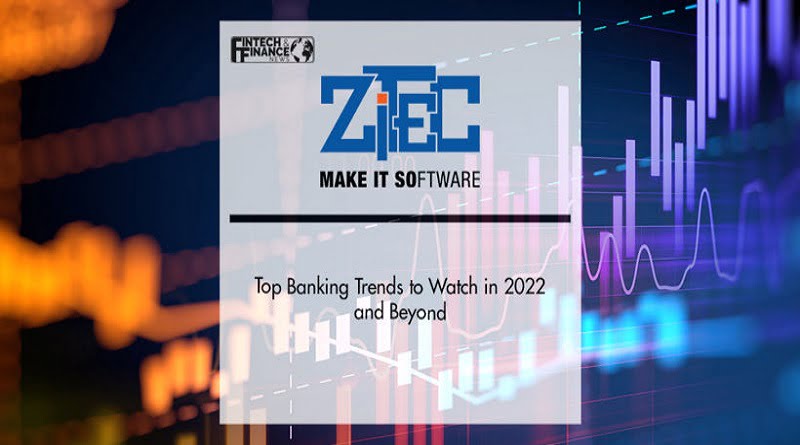TOP BANKING TRENDS TO WATCH IN 2022 AND BEYOND
Over the past two years, digital transformation has reached unprecedented levels in businesses across all industries as organizations pivoted in the face of the pandemic. In 2022, digital transformation will continue to be an umbrella term for innovation strategies and other developments in banking. It will play a crucial role in leading the change in the global economy and will further impact the banking space.
The banking ecosystem is usually shaped, sometimes even disrupted, by a confluence of forces which turn this space into a very dynamic and competitive one. Among these forces, regulations and advances in technology have the greatest impact, leading to competition, which ultimately benefits consumers. Moreover, there are also social implications, such as rising customer expectations, aging population, and the increasing dominance of digital natives (generation Z or “zoomers”). Eventually, all these aspects make banking better and cheaper, undermining traditional business models.
PLATFORMIZATION OF BANKING
Traditionally, banks have offered their own products through their own channels to customers. A full open platform (or marketplace) of financial products and services would open new revenue streams, bring benefits to consumers, and scale through the power of partnerships.
In a report released in September 2021, the European Banking Authority has identified a rapid growth in the use of digital platforms to ‘bridge’ customers and financial institutions. Platformization presents a range of potential opportunities for both EU customers and financial institutions. Some of these opportunities come from the fact that most banks run on outdated IT infrastructures. These were deployed decades ago and were built on monolithic architecture, where databases, user interface, and server applications are managed in one place (hence the so-called legacy system; you can read more on how to modernize your legacy applications in one of our articles). Being open, modular, and scalable is nearly impossible when trying to build new value-adding products and services on top of banks’ most valuable asset, customer data, and further explore the benefits of the platform/marketplace business model.
In order for banks to adopt this model, they need to evolve from a legacy technology stack to more open, interoperable, and scalable architectures. By opening up their proprietary core banking systems to an open source architecture, banks could enable an efficient integration of internal systems with other partners (and their products). This open structure would enable a microservice architecture, allowing banks to build new revenue streams and reposition themselves on the market.
EMBEDDED FINANCE
Using API-driven interfaces to integrate financial capabilities within online environments, or embedded finance, is currently perhaps the most discussed banking trend, even though the idea behind it is not quite new; it’s what superapps or lifestyle apps like Alipay, Grab or WeChat have been doing for quite some time.
Embedded finance is perceived as a threat to incumbent financial institutions, but they can capitalize on this opportunity by creating new distribution channels for their products and services and/or replicate the approach by embedding fintech products into their own digital banking platforms. According to research from J.P. Morgan, software companies that embed payments into their platforms see a 2- to 5-time increase in revenue per customer. Moreover, embedded finance will generate USD 230 billion in revenue by 2025, a 10x increase from USD 22.5 billion in 2020. On the other hand, as more and more fintechs are looking for bank partners to provide banking services, banks can offer a banking-as-a-service solution using an existing licensed secure and regulated infrastructure. The services are delivered through the bank’s API platform or through a third-party platform.
OPEN BANKING, OPEN FINANCE, AND OPEN DATA
According to research conducted by Accenture in 2021, 76% of banks worldwide expect customer adoption and open banking API usage to increase by 50% or more in the next three to five years. The UK is still leading the way in open banking, with almost four million individuals and small businesses active users of open banking-enabled products. Mostly regulatory-driven, this innovative approach was orchestrated by an implementation body, the Open Banking Implementation Entity (OBIE), which acted as a catalyst, bringing regulatory bodies and commercial entities together in building financial solutions. Similar initiatives have emerged in other countries as well, with more to follow in 2022.
In this wave of innovation opened up by the Second Payments Service Directive (PSD2), from the very beginning banks had no financial incentive to share their most valuable asset: customer data. Moving from a compliance process that forced banks to open up customers’ data, with their consent, to third parties to envisaging and exploring this opportunity, the industry is still waiting to see more successful use cases in payment initiation, besides account aggregation. Open Banking hasn’t reached its expected potential yet. In 2 years since coming into effect, fluent APIs, speedy transactions, and hundreds of fintechs using the interfaces to incumbent banks are not there yet.As open banking only involves the sharing of financial data by banks, use cases are limited to products offered by banks (loans, mortgages, savings and checking accounts, etc.). Open Finance is the next step, bringing the global economy closer to Open Data, a data-driven system that will connect finance and technology, allowing consumers to fully own their data and derive benefit from them. Open Data is the ultimate destination of global economies, but legacy systems, the difficulty of accessing information, and different standards from one country/region to another need to be addressed.
MORE INNOVATION OPPORTUNITIES FOR THE PAYMENTS SPACE
According to statistics, the global digital payment market size is expected to grow at a CAGR of 15.2% between 2021-2026. Overall, directly or indirectly impacted by the innovation in the financial services ecosystem, payments will continue to be at the forefront of digital transformation, mostly due to the high increase in ecommerce sales. (Since there’s a lot going on in this space, we’ll approach this topic in a separate article to be published soon.)
Alternative payment methods have proven lately to be on the radar for the entire value chain. Mobile payments, bank transfers, digital wallets, cryptocurrencies, or buy now pay later (BNPL) are some of the alternative payment methods with high growth usage and potential to bring new levels of convenience for consumers and merchants alike. In particular, thanks to the emerging use cases being implemented on open banking rails, customers can pay for online purchases instantly from their bank account rather than using a card-based payment. On the other hand, there are BNPL platforms, which have skyrocketed in the pandemic, such as Klarna, Sezzle or Afterpay. These enable consumers to buy almost anything and then pay it off in split monthly payments, usually interest free. As an unregulated form of credit, BNPL spiked during the pandemic as consumers shifted many purchases to digital channels. Globally, CB Insights projects BNPL purchase volumes to grow as much as 10-15x by 2025.
NEOBANKS WILL CONTINUE TO FIND NEW REVENUE STREAMS
Also known as “tech companies with a banking license”, neobanks rapidly grew a customer base by serving a niched portion of the market really well. At the core of their business, personalization, stellar customer service, and good marketing are key, which make them very appealing to digital natives and underserved segments of the market. For the already established neobanks that managed to accumulate a substantial customer base, moving forward will mean capitalizing on scale and becoming profitable. In 2021, we’ve already seen some investments and acquisitions around mortgages (bunk, Starling), buy now pay later (BNPL) solutions (Revolut, Monzo), or AI (Nubank). Mortgages in particular are an opportunity for digital banks to onboard users for the long-term, thus creating a source of sustainable income.
CLOUD AND MULTI-CLOUD COMPUTING MIGRATION AND ADOPTION
Banks will likely spend more on migrating their platforms to the cloud in 2022. According to a Genpact study, CIOs in the banking industry say that ”re-platforming applications to function in the cloud” helped their companies to adapt over the past year.
On the other hand, a recent survey by Harris Poll and Google Cloud shows that banks are taking steps to mitigate risks from their use of external cloud computing services. The survey of 1,300 leaders in financial services in 10 countries shows that 83% were using the cloud as part of their primary computing infrastructure. Regulators believe that reliance on the same providers could create risk, a multi-cloud strategy proving more optimal. Multi-cloud would allow banks to switch to an alternative provider in case of an outage.
Recently, Microsoft has launched a financial services-specific cloud offering, Microsoft Cloud for Financial Services, which integrates cloud services across Microsoft Azure, Microsoft 365, Dynamics 365, and Power Platform. This service comes with capabilities and customization tailored to the financial services industry. Therefore, addressing industry-specific pain points when it comes to cloud migration could get easier.
CONCLUSION
In the banking space, whether we’re talking about traditional banks, fintechs, or neobanks that offer banking solutions, there’s plenty of room for new opportunities and innovation that brings benefits to consumers and businesses. Eventually, financial services will come with the best of the two worlds: the high level of trust people still place in traditional banks and the unprecedented level of convenience and personalization that fintechs and neobanks bring to the table, all based on the smart use of customer data.
Let’s talk about your project
As companies in the banking sector aim at modernizing applications and benefit from cloud technologies, they need a trusted partner equipped with extensive know-how in planning and migrating existing software platforms to cloud. At Zitec, we are honored to be among the first 20 Microsoft Azure partners globally with demonstrated expertise in migrating software platforms running on Linux and/or MySQL, PostgreSQL, and MariaDB databases to Microsoft Azure.








